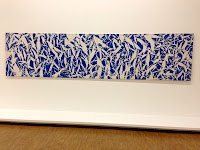I would think that when you see a painting like this, perhaps you know the name of the artist.
 |
| Etude 1969 |
 |
| The Tabulars |
 |
| meun 1964 |
 |
| Tabula 1980 |
I saw Simon Hantaï’s work for the first time (1922- 2008) and these paintings as it so happens, at the Museum of Modern Art some ten years ago. Quite frankly, they didn’t do anything for me and seemed more an imitation of Klein’s blue paintings and a few others of the same period - the early 70’s. A repetition of a design, in a colour is a bit gadgety in my book. But then, I am not keen on repetition....
In reading Beaux Arts Magazine this month there was a lengthy article describing this artist’s work. The first retrospective for nearly forty years. Perhaps I should make the effort to go down to the Beaubourg and see.....?
Before I picked up the brochure at the centre, I turned suddenly and saw this.
«Oh no, I said to myself, we are not going to have sleeping vagabonds in the centre from now on».
Other people had the same look on their faces as I did - one of faint disgust. Then I looked a little closer. It was a «mole» created by Mary Jenkins and Sandra Fernandez. The realism was extraordinary. I breathed a sigh of relief and went up to the 6th floor.
This exhibition, I could feel, would be exploratory for me- he couldn’t of done the same work for over 60 years. Hantaï was born in Hungary and studied at first in the Fine Arts school in Budapest. A city I love and the last city visited with my Mother before she died. So many wonderful galleries and museums and a city which feels out of this age. Hantaï was of the generation who moved to Paris immediately after the war. He was highly taken with Surrealism and this was my first shock.
 |
| surrealist period |
 |
| Les Baigneuses 1948 |
 |
| surrealist period |
 |
| L'Arbre des lettrés 1950-51 |
 |
| Narcisse collectif 1953 |
 |
| painting..... |
How on earth had he done such work and in fact it moves on the be something like Jackson Pollock’s. He moved away from both movements in the mid 50’s and then started to develop an abstract line of work, which later became his hallmark. This was something he wanted to do as with the dripping technique, he knew it was often used by other artists and surrealism was «out».
 |
| Sexe prime - Hommage à Jean-Pierre Brisset 1955 |
 |
| Duchamp effacé 1951-60 |
 |
| peinture 1959 |
 |
| peinture 1956 |
 |
| peinture 1957 |
So many of these paintings were called "peinture" or simply "painting" as if he hadn't as yet found what he was searching for. I might add, that most belonged to private collectors.
But he is, best known for his work using «pliage» or what he called «folding as a method». This started in the 60’s. The canvas was folded before painting concealing a view of the entire surface from the artist who only painted the accessible parts. This could be called an «imposed blindness» and led to a profound upheaval in Hantaï's work. He reinvented new methods all the time giving them such names a the «Mariales»
A SERIES OF MARIALES 1960+
or the «Laissées",(1981-95) "Blancs" (1973-74) the "Etudes" (1969) "Catamourons" (1963, the "Panses" (1964-65) the "Tabulars" (1973-76) .....
 |
| Del Parto - Tabula 1975 |
 |
| Catamurons 1 1963 - I ADORE THIS |
 |
| Panse 1964 |
 |
| Catamurons 1963 |
 |
| Meun 1964 |
 |
| meun 1964 |
 |
| Blanc 1973 |
 |
| Blanc 1974 |
 |
| Pliage à usage domestique 1990 |
 |
| No title |
 |
| Tabula 1980 |
 |
| Tabula 1980 |
 |
| Laissée 1981 |
And from no-where, I discovered these and really like them.....
 |
| peinture 1957 |
 |
| souvenir de l'avenir 1967 |
In actual fact I prefer to see his work "out of sequence" as above, rather than displayed in series.
He also cut up his own work to experiment with other techniques.....
There were over 130 paintings in this retrospective dating from 1949 up until the 90’s. His work is rich and certainly beyond what I imagined it to be from the initial «foldings» that he is so associated with. Certain artists I recognize at once - Picasso is one of them - but if such paintings as some above had been thrust under my eyes, I certainly could not have identifed them as Hantaï’s work, nor for that matter could I have suggested another painter. It goes to show that some painters have a palette which is so extensive that it is difficult to categorize their work. Preconceptions of artist’s work should definitely be avoided.
 |
| Extract of a letter in 2000 |
Of course, if I had received a postcard like this, I doubt if my patience would have stood up to the test of trying to decipher it.
And frankly, I would not live in such an environment....
could you?
 |
| 1976 - in his studio |















































Commentaires